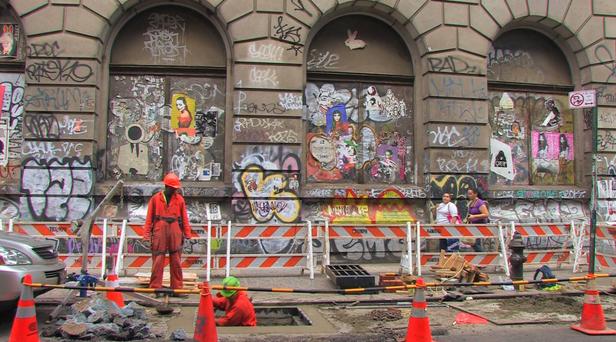Fred Radke buffs Banksy and can’t stand public mural walls, even when they’re meant to inspire hope in his post-Katrina NoLa.
Joe Connolly deals with the death of his 11-year old son by zealously trucking around cans of paint and paint-removing chemicals, occasionally throwing up his own tag as a caution sign to the other, bad, graffiti artists.
Jim “Silver Buff” Sharp will even take down signs for lost dogs in his mission to purge Berkeley’s streets of DIY expression.
Meet your anti-graffiti activists, courtesy of a new film by Berkeley producers, Vigilante Vigilante.
The movie, shot over the course of 500-some days by Max Good and Nathan Wollman, gives a breathless history of people writing on walls (including a dubious reference to graff buffers back in the Paleolithic days), right up to modern day Bay Area strife – anybody remember the Warm Water Cove “clean-up”? The timeline focuses on the conflict between taggers and law-and-order types. If, in this age of JR and other highly-publicized and lauded street art, you don’t think is for real anymore, watch this video.

Good capturing Sharp’s technique
The movie then moves onto Good and Wollman’s mission to expose the unaffiliated lone wolfs who spend their days erasing other people’s works of self-expression. They travel across the country, gaining surprising amounts of access to the three men’s routines.
But as it turns out, Vigilante isn’t down to use the middle-aged to elderly white guys they profile (add to this list a one “Silver Circle” from Portland, who is now retired) as the faces of evil. Instead, the movie couches its critique in the wack broken windows sociological theory – itself a tool used by elite populations to justify wiping clean the visible signs of any disenfranchised citizens.
By the end of the movie, Good and Wollman are arranging meet-ups between the anti-taggers so that they can swap paint-matching and poster removal techniques. The scene is almost heartwarming: the anti-graffiti vigilantes, with their relentless schedules and dedication to their craft almost win the audience over. Even if we’re a little creeped out by them.

Coca Cola vs. Twist’s tag wall: Which is the visual pollution?
So who is the villan in all this? Vigilante Vigilante finds a plausible symbol of nefariousness: James Q. Wilson, the sociologist behind the broken window theory (the inspiration, by the way, for Rudy Giuliani’s 1990s purging of downtown Manhattan).
The producers were right to do so. For the community member upset that their neighborhood is poor, that their area’s youth are unemployed, that circumstances seem beyond their control, Wilson’s theory successfully obfuscates cause and effect, a standard conservative trick of defeating class consciousness. Graffiti doesn’t cause race riots, poorly-dealt-with natural disasters, or high unemployment rates. Writing on a wall is often the response to a society that belittles minority youth, the middle class and poorer, and anyone who is having trouble with the capitalistic treadmill. Jeff Chang‘s Can’t Stop Won’t Stop is a great place to start if you’re interested in this anti-colonialist view of street art.
The obsessive cover-ups of the vigilantes (that in more than one case have morphed into tags themselves, a fact the filmmakers highlight when they begin covering up Sharp’s silver buffs with neon pink and gold buffs, to his dismay), are ultimately their attempt at regaining control in a world that can seem really mean at times. Which doesn’t change the fact that what they’re doing is lame — can hardly blame this guy…

Vigilante Vigilante is at the Roxie through Sat/20

